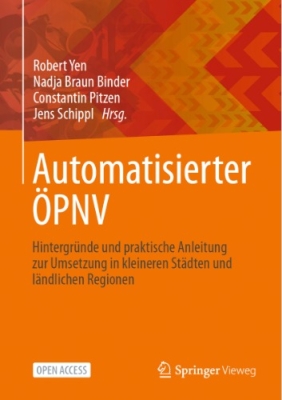How does increased home office activity affect urban development and mobility?
In the planning discourse, the extent to which physical changes of location can be replaced by information and communication technologies has been discussed for decades (BMVI, 2020). Although the home office is not a new invention, this form of work has gained central relevance through the COVID-19 pandemic (Alipour et al., 2020). According to the panel study Mobility in Times of Crisis(Mobilität in Krisenzeiten) by the German Aerospace Center (DLR), 32% of employed persons pursued their work entirely or partially in a home office during the first phase of the shutdown in April 2020 (DLR, 2020). The proportion of professionals always or partially working in a home office increased from 32% in April 2020 to 38% in summer 2020 and finally 40% in autumn 2020 (ibid.).
The increased use of home office during the coronavirus pandemic and a rethink in companies point to a recognisable trend towards home office (Fraunhofer IAO, 2020; DLR, 2020; bitkom, 2020). In a recent survey by the Fraunhofer Institute for Industrial Engineering IAO, 42% of the companies surveyed stated that they wanted to actively expand the range of home office options for their employees in the future (Fraunhofer IAO, 2020). A survey of personnel managers by the ifo Institute for Economic Research (ifo, 2020) shows that 73% of the companies that relied on working from home during the pandemic also want to offer more options in the future.
Increased work in the home office and the use of video conferencing can avoid long journeys. In the area of daily commuter traffic, home office has the potential to relieve the traffic systems, for example by reducing selective traffic peaks. There is also the possibility of reducing direct energy consumption, especially by reducing commuting traffic, but also office space and the associated energy costs (see Perch-Nielsen et al., 2014).
A recent study by the Institute for Futures Studies and Technology Assessment on behalf of Greenpeace (Greenpeace, 2020) estimates the possibleCO2e savings for Germany with an increased intensity of home office use. Two scenarios are used as a basis: one with a home office share of 25 percent and one with a share of 40 percent of employees. Both scenarios distinguish between one and two additional home office days per week. The study comes to the conclusion that, depending on the variant, between 1.6 and 5.4 million tonnes ofCO2e could be saved by eliminating commuting trips amounting to between 10.9 and 35.9 billion person-kilometres per year. In the highest variant, this corresponds to a reduction in emissions from commuting by 18 per cent, while in the lowest variant, commuting emissions are still reduced by about five per cent (Bonin et al., 2020).
These potentials of mobile working also face risks. In the long term, the increasing use of the home office could lead to a change in the choice of residence or workplace, with greater distances being accepted. As a result, the gains in passenger transport performance could be lost again (BMVI, 2020). The long-term effects of home office on residence and workplace preferences must also be considered.
The omnipresent topic of home office also has implications for urban development. In the short term, an increased use of home office will have its effects mainly within the major cities and their immediate surroundings. The trend towards a reduction in living space per capita that has been recorded in major German cities in recent years conflicts with the home office (Adam and Klemme, 2020: 13). The apartment size is becoming increasingly important in the search for housing. Demand on the housing market will therefore intensify as the need for in-house space will continue to increase.
At the same time, office demand will be affected in the medium to long term, as a new projection by the German Economic Institute shows. For Berlin, for example, office rents are forecast to fall by 20% (Voigtländer, 2020). The declining trend in demand for office space can bring with it an enormous push for change. The conversion of office buildings and commercial buildings into residential space, which has been very slow in practice so far (cf. BBSR, 2017), is likely to experience a strong upswing in the coming years. This development can make a decisive contribution to relieving tense housing markets and to the "reurbanisation of the inner city" (cf. BMVBS, 2010).
By shifting work to the home, the spatial separation of home and work is at least partially overcome. As a result, the surrounding areas of metropolitan areas could become more attractive as places to live. Already in recent years, the surrounding areas of cities had gained in importance compared to metropolitan areas (cf. OECD, 2019). "Recent studies on development within metropolitan regions show that the importance of medium-sized cities as residential locations is increasing" (Eltges, 2019: 2). This development has been further reinforced by coronavirus pandemic.
At the same time, the surrounding radius is increasing. Rural regions in the further hinterland of metropolises can gain a higher status. A data analysis by Immobilienscout24 shows that the demand for houses in rural areas has been rising continuously since mid-March 2020. Holiday regions have benefited particularly strongly from this (Schönball, 2020). New opportunities are also opening up for peripheral and/or structurally weak cities. Mobile work and concepts such as co-working spaces can make working life more flexible and reduce distances in rural areas (BMEL, 2020). An important prerequisite for this is a well-functioning digital infrastructure. At present, it is uncertain what impact the trend towards home offices, which is already apparent today, will have on the long-term development of cities. In view of climate change and the need to reduce greenhouse gas emissions to zero by 2050, there is an opportunity to consider the impact of the pandemic on urban development and mobility in the context of existing challenges. The current crisis must be used as an opportunity to holistically design development and planning processes and implement concrete measures. Because only integrated urban development makes cities more crisis-proof and liveable.
Author: Tania Gianneli
PDF | Homeoffice und Implikationen für die Stadtentwicklung und Mobilität
PDF | Home office and implications for urban development and mobility






